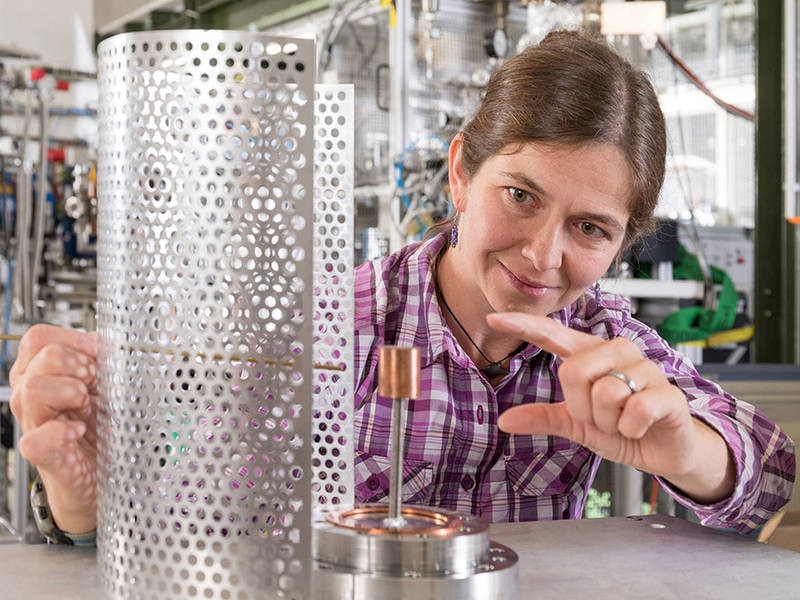Mar 1 2019
Researchers have succeeded in luring the antiparticles of electrons—positrons—into a magnetic field trap, for the first time. The team included scientists from the Max Planck Institute for Plasma Physics (IPP) and the Technical University of Munich (TUM).
 Dr Eve Stenson uses spare parts to demonstrate the structure of the positron trap. (Image credit: Axel Griesch/IPP)
Dr Eve Stenson uses spare parts to demonstrate the structure of the positron trap. (Image credit: Axel Griesch/IPP)
This significant achievement could pave the way for producing a matter-antimatter plasma of positrons and electrons, similar to the plasmas that are assumed to occur in the vicinity of black holes and neutron stars. Dr Eve Stenson described her research work in a recent interview. The following are excerpts from that interview.
The significance of luring positrons into a trap
According to Dr Stenson, the ability to capture and confine positrons is important for analyzing the so-called electron-positron pair plasma, and such plasmas hold significant interest for investigating the central questions in both plasma physics and astrophysics.
Challenges about catching positrons
The antiparticles of electrons—positrons—possess the same types of characteristics except that they are positively charged and not negatively charged. When an electron is hit by a positron, both these particles annihilate immediately in a flash of light. Moreover, the fact that there are abundant numbers of electrons everywhere on Earth makes it rather challenging to preserve positrons in a way that would allow them to survive for at least a while, informed Dr Stenson.
Providentially, the researchers now have the world’s most robust positron source, called neutron-induced positron source Munich (NEPOMUC), in Garching, north of Munich, at the Research-Neutron source Heinz Maier-Leibnitz (FRM II). This positron source can generate 900 million positrons every second, added Dr Stenson.
Decades of unsuccessful simulation of electron-positron plasma could soon become a reality
According to Dr Stenson, guiding charged particles like the positive positrons into a magnetic trap is extremely difficult. Unfortunately, the same rules of physics that limit the particles within this trap also prevent the particles from entering. The researchers’ trap has a magnetic field, which is quite similar to that of other celestial bodies, including Earth. It was the researchers who developed the idea to apply an electrical voltage briefly to the trap’s edge so as to lure the positrons via the magnetic “bars”. When the voltage was again switched off, the positrons remained trapped in the cage. The method worked so well that even the researchers were very surprised.
Duration of positrons’ confinement
The team was able to confine the positrons for a little more than a second, informed Dr Stenson. So far, none of the team in the world has successfully done this with antimatter, especially in this kind of trap.
Benefits of the results for plasma physics and other areas
The objective of the APEX (A Positron-Electron Experiment) Group at the Max Planck Institute for Plasma Physics is to create a matter-antimatter plasma of positrons and electrons and also to confine that kind of plasma in a magnetic trap. However, the initial step would be to create and store a sufficient number of positrons. Creating and examining such plasmas will form the next step, Dr Stenson added.
It is assumed by astrophysics that such unusual plasmas occur near black holes and neutron stars. In terrestrial plasma physics, the symmetry of electron and positron masses is anticipated to result in innovative findings on turbulence and waves in plasmas—findings that could aid in using nuclear fusion to generate power in the coming years, concluded Dr Stenson.